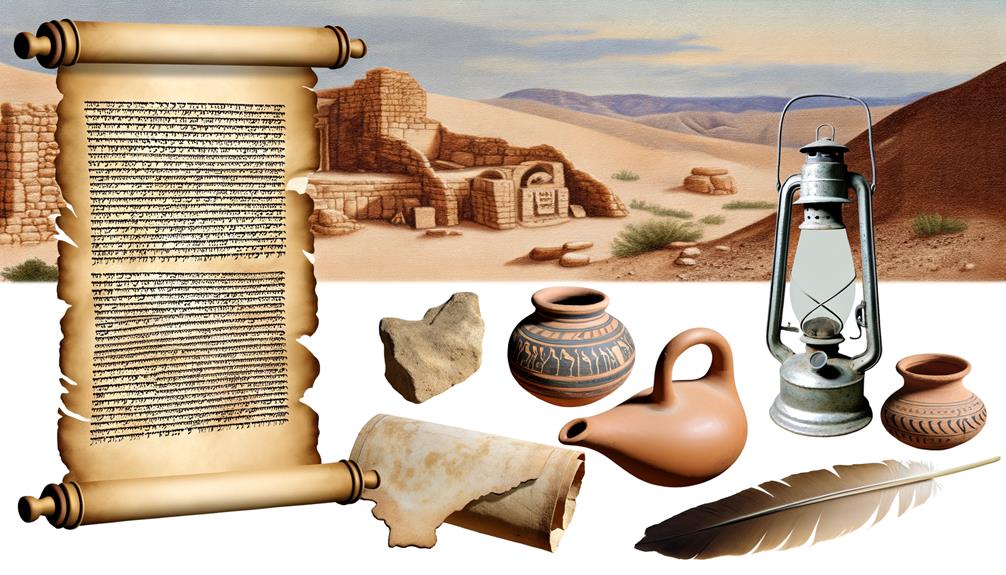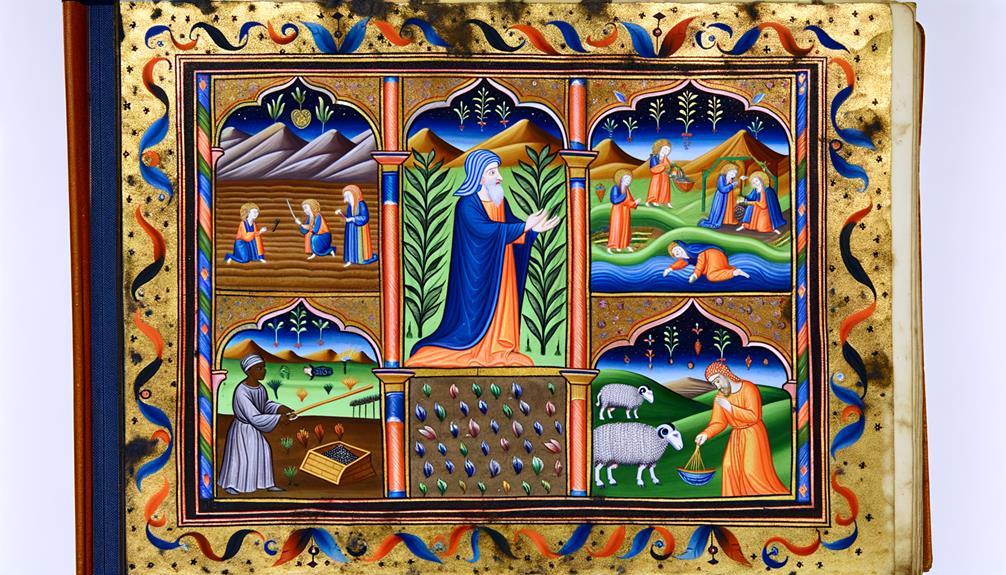Fortified Meaning In The Bible: Strength and Protection
In the Bible, ‘fortified‘ embodies both the tangible defense mechanisms of ancient cities—such as walls, towers, and gates—and rich spiritual symbolism. It signifies divine refuge and protection, reflecting God’s role as a stronghold for believers.
The term is often utilized metaphorically in Psalms and prophetic literature to illustrate God’s unwavering support and shelter amidst life’s adversities. Literary devices such as metaphor, parallelism, and personification deepen this theological concept, portraying the spiritual resilience in adhering to divine covenants.
To explore the multifaceted dimensions of ‘fortified’ in biblical narratives further enriches one’s understanding of faith and divine assurance.

Fortified Meaning in the Bible: Spiritual Strength and Divine Protection
| Aspect | Biblical Insight |
|---|---|
| Definition | Strengthened or protected, often by God’s power or divine intervention |
| Old Testament Reference | Proverbs 18:10 – “The name of the Lord is a fortified tower…” |
| New Testament Reference | Ephesians 6:10-11 – “Be strong in the Lord and in His mighty power…” |
| Symbolism | Security, spiritual defense, and unwavering faith in God |
| Spiritual Application | Encouragement to rely on God for strength and protection in life’s battles |
Historical Context

In examining the historical context of the term ‘fortified‘ in the Bible, it is essential to understand the sociopolitical and military landscape of ancient Israel and its neighboring civilizations.
Fortifications were vital for the protection of cities and settlements, representing both physical and symbolic strength. The frequent invasions and conflicts necessitated robust defensive structures such as walls, towers, and gates.
This period saw Israel surrounded by powerful empires like Egypt, Assyria, and Babylon, all of which influenced their fortification strategies.
Theologically, these fortresses also symbolized divine protection and covenant fidelity. Consequently, the term ‘fortified’ transcends mere physical defense, embodying a broader spiritual and communal resilience rooted in faith and divine assurance.
Literary Devices

Examining the term ‘fortified’ within the biblical text reveals not only its historical and theological significance but also the rich tapestry of literary devices employed to convey its multifaceted meanings.
Metaphor, for instance, transforms ‘fortified cities‘ into symbols of divine protection and strength.
Parallelism enhances understanding by juxtaposing human frailty with divine fortification, as seen in Psalms.
Alliteration, particularly in Hebrew poetry, underscores the steadfastness of God’s promises, making the term more memorable.
Additionally, personification endows abstract concepts like faith and righteousness with the qualities of a fortified structure, enriching theological discourse.
These literary devices intricately weave the concept of ‘fortified’ into the fabric of biblical narrative, illuminating its depth and complexity for the discerning reader.
Spiritual Symbolism

The concept of ‘fortified’ in the Bible transcends its literal meaning, serving as a profound spiritual symbol of divine refuge and strength for believers.
This metaphorical representation is deeply rooted in theological contexts, where God is depicted as a fortress, shielding His followers from spiritual adversaries.
Psalms 18:2, for instance, illustrates this with the words, ‘The Lord is my rock, my fortress, and my deliverer.’
Here, ‘fortified’ embodies the unwavering protection and stability provided by faith in God.
It highlights the divine assurance of safety amidst life’s tribulations, urging believers to find security in their spiritual bond with the divine.
Therefore, ‘fortified’ transcends mere physical defense, embodying an eternal, spiritual sanctuary.
Parables and Allegories

Parables and allegories in the Bible serve as profound vehicles for conveying theological truths through symbolic narratives.
By employing familiar elements of daily life, these stories encapsulate complex spiritual lessons, inviting deeper reflection.
The layers of meaning within these narratives often transcend their immediate context, revealing insights into divine principles and human nature.
Symbolism in Parables
In biblical literature, parables employ rich symbolism to convey deeper theological truths and moral lessons. These narrative devices use everyday elements to illuminate spiritual realities, making complex doctrines accessible and memorable. Symbolism in parables often encapsulates profound insights, inviting readers to explore beyond the literal narrative.
- The Sower and the Seeds: Represents different responses to God’s word, highlighting spiritual receptivity and growth.
- The Prodigal Son: Embodies themes of repentance, forgiveness, and divine grace.
Through these symbolic narratives, parables engage the audience in reflective thinking, promoting a deeper understanding of divine principles and ethical conduct within a theological framework.
Allegories’ Deeper Meanings
Allegorical narratives in the Bible provide a profound avenue for understanding complex theological concepts through multi-layered storytelling. These narratives, such as the Parable of the Sower (Mark 4:3-20), transcend their literal meanings, offering readers insights into divine truths and moral imperatives.
The deeper meanings embedded within these allegories often challenge believers to reflect on their spiritual condition and relationship with God. For instance, the Good Samaritan (Luke 10:25-37) not only teaches about compassion but symbolizes Christ’s redemptive grace.
Prophetic Messages

Prophetic messages in the Bible often embody layers of divine intent that necessitate careful theological interpretation.
These messages are rich with symbolism, serving not only as foretellings but also as reflections of God’s covenantal relationship with humanity.
Understanding the intricate symbolism within these prophecies is essential for comprehending their profound spiritual and eschatological implications.
Interpreting Divine Intent
Understanding divine intent within prophetic messages necessitates a nuanced approach that considers historical context, literary forms, and theological implications. Prophetic texts often convey God’s will and future plans, requiring readers to discern layers of meaning beyond the literal. By engaging in a thorough exegetical study, one can uncover insights about divine intentions and their relevance for contemporary faith.
- Historical Context: Understanding the socio-political circumstances during which the prophecy was given helps illuminate its original meaning.
- Literary Forms: Recognizing genres such as poetry, narrative, or apocalyptic literature aids in interpreting the message accurately.
This tripartite methodology fosters a deeper comprehension of biblical prophecies.
Symbolism in Prophecies
Symbolism in prophetic messages serves as an essential interpretative key, revealing deeper spiritual truths and divine mysteries through metaphorical language and vivid imagery.
Biblical prophecies often employ symbols—such as beasts, horns, and lamps—to convey complex theological concepts and eschatological events. For instance, the Book of Revelation uses the image of a dragon to symbolize satanic forces, providing a rich tapestry for theological reflection.
Contextual analysis is vital, as these symbols were often rooted in the cultural and historical milieu of the time. Interpreting these symbols requires a nuanced understanding of biblical literature, as well as an appreciation for the layers of meaning that transcend literal interpretations, thereby uncovering the profound divine messages intended for believers.
Covenants and Promises

When examining the fortified meaning in the Bible, the concepts of covenants and promises emerge as fundamental theological constructs that shape the narrative and relational dynamics between God and humanity.
These divine agreements serve as pivotal moments in biblical history, reflecting God’s enduring commitment and humanity’s response.
- The Abrahamic Covenant: Establishing a chosen people and land.
- The Mosaic Covenant: Providing laws that define the moral and societal structure of Israel.
Analyzing these covenants reveals a progressive revelation of God’s plan, illustrating a continuity and fulfillment that underscores the Bible’s overarching message.
Each covenant not only forges a deeper relationship with God but also sets a framework for understanding His promises.
Moral Teachings

Moral teachings in the Bible serve as foundational principles that guide ethical behavior and inform the believer’s relationship with God and others. These teachings encompass commandments, parables, and exhortations, providing a framework for righteousness and justice.
For instance, the Ten Commandments outline essential duties toward God and fellow humans, shaping moral consciousness. The Sermon on the Mount further expounds on virtues like humility, mercy, and peacemaking, emphasizing internal purity over external compliance.
Contextually, these teachings address societal norms while transcending time, revealing universal truths about human nature and divine expectations. Theologically, they reflect God’s character and will, urging believers toward a life of holiness and love.
Understanding these principles enables a deeper, more fortified faith journey.
Poetic Imagery

Poetic imagery in the Bible serves as a profound literary tool that conveys theological truths and enriches the narrative with layers of symbolic meaning. Through vivid metaphors and similes, the text evokes emotional responses and deepens the reader’s spiritual engagement. Imagery such as the “Good Shepherd” or the “Vine and Branches” transcend mere description, offering a rich tapestry of divine-human relationships and moral teachings.
Symbolism: Imagery like “light” and “water” emphasizes purity and life, essential themes in biblical theology.
Metaphors: Figures like the “Lion of Judah” and “Lamb of God” encapsulate Christ’s dual nature of kingship and sacrifice.
Similes: Comparisons such as “faith like a mustard seed” underscore the power and potential of belief.
These elements collectively enhance the interpretive depth of biblical texts.
Wisdom Literature

Wisdom Literature in the Bible offers profound insights through three distinct yet interconnected books:
Proverbs provides pragmatic daily guidance.
Ecclesiastes contemplates the existential meaning of life.
Job addresses the complexities of suffering and endurance.
Each text contributes a unique perspective on human experience and divine interaction, forming a thorough theological framework.
Proverbs’ Daily Guidance
In the context of biblical wisdom literature, the Book of Proverbs offers practical, daily guidance aimed at cultivating a life of righteousness and discernment. Proverbs encapsulates timeless truths that address the moral and ethical dilemmas faced by individuals.
By employing aphorisms and poetic devices, it imparts wisdom that is both accessible and profound.
Theologically, Proverbs emphasizes the fear of the Lord as the foundation of wisdom, urging readers to align their lives with divine principles.
- Moral Conduct: Proverbs 11:3 underscores the integrity of the upright versus the deceitfulness of the wicked.
- Discernment: Proverbs 3:5-6 encourages trusting in the Lord rather than one’s own understanding.
This guidance fosters ethical living and spiritual growth.
Ecclesiastes’ Life Reflections
While Proverbs offers practical daily guidance, Ecclesiastes provides a profound reflection on the meaning of life, grappling with existential questions and the transient nature of human endeavors.
Authored by the Teacher, Ecclesiastes explores the futility of earthly pursuits, emphasizing the ephemerality of human achievements and pleasures. The recurring refrain, ‘Vanity of vanities, all is vanity,’ underscores the fleeting nature of worldly success.
Yet, amidst this existential angst, Ecclesiastes points towards a divine resolution: the fear of God and adherence to His commandments as the ultimate purpose. This theological perspective marries human disillusionment with divine wisdom, urging readers to transcend temporal pursuits in favor of eternal truths.
Consequently, Ecclesiastes enriches the biblical discourse with its candid exploration of life’s enigmas.
Job’s Endurance Lessons
The narrative of Job, a pivotal piece within Wisdom Literature, explores the profound theological and philosophical dimensions of human suffering and divine justice. Job’s endurance through immense suffering offers timeless lessons:
- Sovereignty of God: Job affirms God’s ultimate authority and inscrutability, challenging simplistic views of retributive justice.
- Human Limitation: Job’s dialogues reveal the limits of human understanding in grappling with divine purposes and the mystery of suffering.
These elements invite readers to reflect on the complexities of faith, encouraging a deeper contemplation of divine-human dynamics.
The Book of Job remains an essential text for those grappling with the intricate interplay of suffering, justice, and faith.
Faith Principles

Faith principles in the Bible serve as foundational elements that guide believers in their spiritual journey and moral decision-making. These principles encompass trust in God’s sovereignty, the necessity of unwavering belief, and the importance of obedience.
Hebrews 11:1 defines faith as ‘the substance of things hoped for, the evidence of things not seen,’ emphasizing trust beyond empirical proof. Contextually, biblical narratives like Abraham’s willingness to sacrifice Isaac (Genesis 22) illustrate profound faith in divine promises.
Theologically, faith is not mere intellectual assent but active reliance on God’s promises and character, as seen in Ephesians 2:8-9, which underscores salvation by grace through faith.
Consequently, faith principles serve as a compass, directing believers towards a life aligned with divine will.
Conclusion
The term ‘fortified‘ in the Bible, juxtaposed against the backdrop of historical context and literary devices, reveals layers of spiritual symbolism and prophetic messages.
Through parables and allegories, it embodies moral teachings and faith principles.
The poetic imagery and wisdom literature further elucidate its theological depth.
This multifaceted concept serves as a cornerstone in understanding divine protection and strength, underscoring the intricate interplay between human frailty and divine fortitude.






